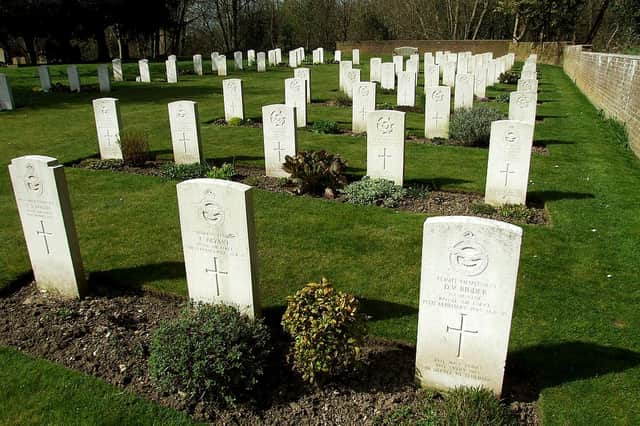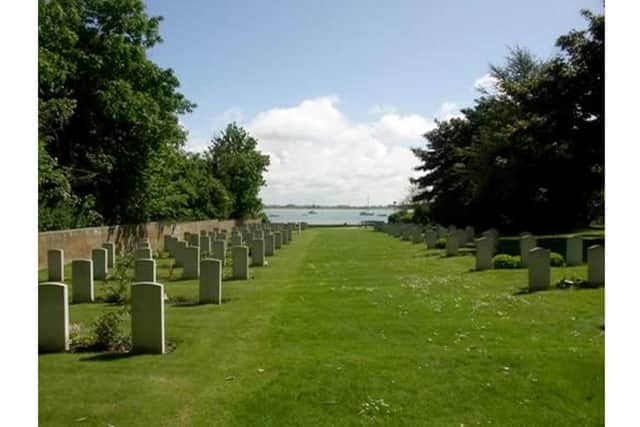Lest we forget... 'some corner of a foreign field' works both ways | Nostalgia


It is on Thorney Island, a stone’s throw from Emsworth, behind St Nicholas’s Church there. It contains 52 Commonwealth and 21 German graves, almost all dating from the Second World War.
The site is open to the public and accessible via the army base with permission. It can also be entered by walking around the island, if you are in the mood for a marvellous seven-mile round trip.
Advertisement
Hide AdAdvertisement
Hide AdRemember that famous poem written by Rupert Brooke? It’s called The Soldier, of which part reads:


If I should die, think only this of me:
That there’s a corner of a foreign field that is forever England
In fact Brooke was a Royal Navy officer who died in 1915.
Perhaps there was a German poet who wrote similar sentiments that might be about German Luftwaffe airmen who were killed on a bombing mission over this part of southern England.
Both the Allies and the Axis power forces were fighting for what they thought was right although for completely different reasons of course. No German invader landed on English soil alive.
Advertisement
Hide AdAdvertisement
Hide AdOn August 12, 1940, a Junkers 88 on a bombing mission over Portsmouth was shot down by RAF fighter pilots.
The plane exploded in over Thorney Island and crashed into a field at Horse Pasture Farm beside Woodberry Lane, Rowlands Castle. One of the crew to baled out, landing on Hayling Island where he was arrested. The three dead, aged 21, 28 and 33, were interred in the cemetery of St Nicholas’s Church, Thorney.
WO2 Peter Hope, Royal Artillery, tells me that today, more than 80 years later, descendants of the German airmen visit to lay flowers on their graves.
When train crews were lumberjacks
I smiled recently when I saw that trains were held up near Botley because a tree had come down. I don’t know how big the tree was but if medium-sized then in days past the train crew would have removed it.
Advertisement
Hide AdAdvertisement
Hide AdIn the days of slam-door stock there was a large red box in the brake van marked ‘Emergency tool box’. Train crews were honour-bound never to open it unless there was an emergency.
Inside were an axe, a saw, a crowbar and other bits and bobs which I cannot now remember. There was also a step ladder strapped to the van’s roof.
On at least three occasions I was a guard when my driver and I had to open the box to clear the track of fallen trees, usually in foul weather. It took time but was much faster than calling out emergency gangs to do the job.
On modern trains there is no emergency tool box and the train has to stay put, sometimes for hours, until it can be rescued.Education in the city
Advertisement
Hide AdAdvertisement
Hide AdToday we all take the education of our children for granted but it was not always so.
Sir Thomas Bramsdon, a one-time MP for Portsmouth tells us that before 1870 education for the masses was inadequate.
There were some good schools such as Church Schools and the Beneficial Society Schools, but with the passing of the 1870 Education Act education for all came alive and School Boards were established by that act.
In Portsmouth the board comprised 15 representatives elected every three years by ratepayers.
Advertisement
Hide AdAdvertisement
Hide AdThe boards remained until 1902 when public education transferred to Portsmouth Corporation.
The City of Portsmouth Corporation Records state: ‘The school board had done its work well and merits great remembrance’. In its 32 years it built 26 elementary schools and a Higher Grade School. Along with 10 church, or non-provided schools as they were called, they accommodated 30,890 children.
I wonder how many of these buildings are still being used to teach children today?Author’s Titanic premonition?
I was watching a strange phenomena programme from the 1960s called One Step Beyond. The enactment was about a woman who sailed on a maiden voyage and had a premonition about the ship’s sinking.
Advertisement
Hide AdAdvertisement
Hide AdAt the end of the programme, the show’s presenter added that in the book Futility, a novel by Morgan Robertson published in 1898, he tells of the sinking of a great ship. She had 19 watertight doors that could be closed within half a minute and with nine compartments flooded the ship would still be safe. Sadly, on her maiden voyage across the Atlantic she hit an iceberg and sank with great loss of life. The name of that ship… The Titan.
I managed to buy a copy of the book online and it is a terrific read more than 120 years later.
A message from the editor, Mark Waldron.
You can subscribe here for unlimited access to our online coverage, including Pompey, for 27p a day.
Comment Guidelines
National World encourages reader discussion on our stories. User feedback, insights and back-and-forth exchanges add a rich layer of context to reporting. Please review our Community Guidelines before commenting.